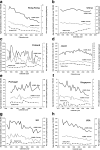Secular trends of salted fish consumption and nasopharyngeal carcinoma: a multi-jurisdiction ecological study in 8 regions from 3 continents
- PMID: 23782497
- PMCID: PMC3729410
- DOI: 10.1186/1471-2407-13-298
Secular trends of salted fish consumption and nasopharyngeal carcinoma: a multi-jurisdiction ecological study in 8 regions from 3 continents
Abstract
Background: Despite salted fish being a classical risk factor of Nasopharyngeal Carcinoma (NPC), whether secular trends in salted fish consumption worldwide accounted for changes in NPC rates were unknown. The relationship between vegetable and cigarette consumption to NPC risk worldwide were also largely uncertain. We investigated the longitudinal trends in standardised NPC incidence/mortality rates across 8 regions and their associations with secular trends in salted fish, vegetable and tobacco consumptions.
Methods: Age standardised mortality rate (ASMR) and age standardised incidence rate (ASIR) of NPC were obtained from the WHO cancer mortality database and Hong Kong Cancer Registry. Per capita consumption of salted fish, tobacco and vegetables in Hong Kong and 7 countries (China, Finland, Japan, Portugal, Singapore, United Kingdom and United States) were obtained from the Food and Agriculture Organization of the United Nation (FAO) and Hong Kong Trade and Census Statistics. Pearson correlation and multivariate analysis were performed to examine both crude and adjusted associations.
Results: There were markedly decreasing trends of NPC ASIR and ASMR in Hong Kong over the past three decades, which were correlated with corresponding secular changes in salted fish consumption per capita (Pearson r for 10 cumulative years : ASIR = 0.729 (male), 0.674 (female); ASMR = 0.943 (male), 0.622 (female), all p < 0.05 except for female ASMR). However such associations no longer correlated with adjustments for decreasing tobacco and increasing vegetable consumption per capita (Pearson r for 10 cumulative years: ASIR = 2.007 (male), 0.339 (female), ASMR = 0.289 (male), 1.992 (female), all p > 0.05). However, there were no clear or consistent patterns in relations between NPC ASIR and ASMR with salted fish consumption across 7 regions in 3 continents.
Conclusions: Our results do not support the notion that changes in salted fish consumption had played an important role in explaining secular trends of NPC rates in Hong Kong and worldwide. Further studies should explore other lifestyle and genetic factors. However, our findings do support the potentially protective effects of vegetable consumption against NPC.
Figures





References
-
- Yu MC, Ho JHC, Lai SH, Henderson BE. Cantonese-style salted fish as a cause of nasopharyngeal carcinoma: report of a case-control study in Hong Kong. Cancer Res. 1986;46(2):956–961. - PubMed
-
- Yu W, Hussain S. Incidence of nasopharyngeal carcinoma in Chinese immigrants, compared with Chinese in China and South East Asia: review. J Laryngol Otol. 2010;123(10):1067–1074. - PubMed
-
- Ho JHC, Huang DP, Fong YY. Salted fish and nasopharyngeal carcinoma in southern Chinese. Lancet. 1978;2(8090):626. - PubMed
Publication types
MeSH terms
Substances
LinkOut - more resources
Full Text Sources
Other Literature Sources
Miscellaneous

